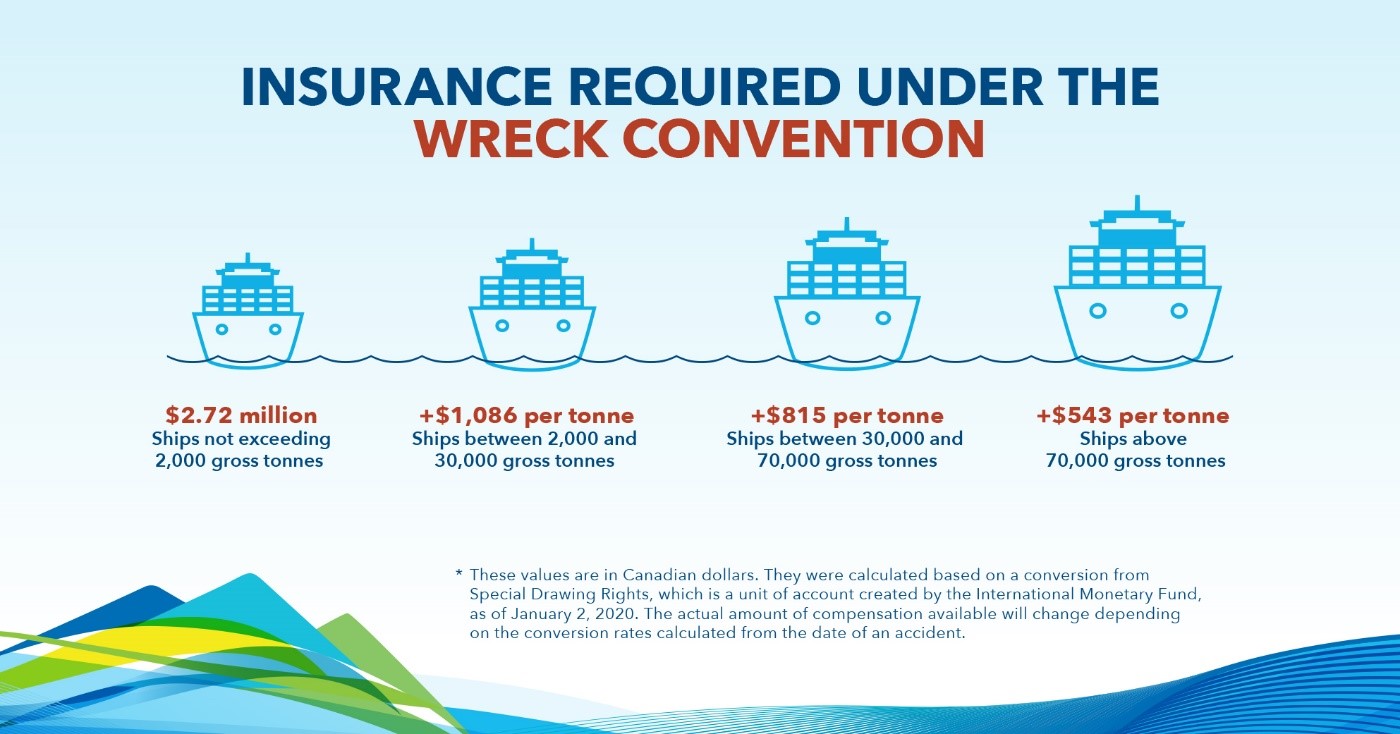Wrecked vessels can create hazards for Canada’s coastal communities. Depending on the location, a wreck can affect navigation and put other vessels and crews in danger. They can also damage marine and coastal environments.
Canada has taken a significant step to protect the public and the marine environment by acceding to the Nairobi International Convention on the Removal of Wrecks, 2007. In Canadian waters, vessel owners are liable for the costs of removing wrecks that affect safe navigation or the environment.
On this page
- What is the Nairobi International Convention on the Removal of Wrecks?
- What is a wreck?
- How much insurance does a vessel need?
- How is the convention enforced?
- What type of vessels does the convention apply to?
- Apply for a Wreck Convention Certificate
What is the Nairobi International Convention on the Removal of Wrecks?
The Nairobi International Convention on the Removal of Wrecks helps make sure that wrecks are quickly and expertly located, marked, and removed by:
- requiring wrecks to be reported
- setting criteria for a hazard assessment to decide what to do with a wreck once it’s been found, and
- including articles (rules) on locating, marking, and removing wrecks
The owner of a wreck must now pay all eligible costs linked to wreck removal.
What is a “wreck”?
A wreck results from a maritime accident. Wrecks include:
- a sunken or stranded ship
- any part of a sunken or stranded ship, including any object that is or has been on board
- anything lost at sea from a ship and that’s stranded, sunk or adrift
- a ship that’s about to, or is expected to, sink or become stranded, where steps to help the ship, or any property in danger, have not already been taken
The convention makes vessel owners responsible for hazardous wrecks. It requires vessels of 300 gross tons or more to carry mandatory insurance to cover the costs of locating, marking, and removing a wreck. Insurance would also cover any losses that need to be claimed because of the wreck, like the removal of debris from the vessel.
How much insurance does a vessel need?
The amount of insurance a vessel needs depends on its size.
Insurance required under the Wreck Convention
The amount of insurance a vessel needs depends on its size.
| Gross Tonnage of Vessel | Amount of Insurance Needed* |
|---|---|
| Ships not exceeding 2,000 | $2,72 Million |
| Ships between 2,000 and 30,000 | $1,086 more per tonne |
| Ships between 30,000 and 70,000 | $815 more per tonne |
| Ships above 70,0000 | $543 more per tonne |
* These values are in Canadian dollars. They were calculated based on a conversion from Special Drawing Rights, which is a unit of account created by the International Monetary Fund, as of January 2, 2020. The actual amount of compensation available fluctuates will change depending on the conversion rates calculated from the date of incident the accident.
How is the Convention enforced?
When travelling in Canadian waters, a vessel of 300 gross tons or more must carry a Wreck Removal Convention Certificate on board. The certificate is proof that the vessel is insured, or has financial security in place, for wreck removal costs.
In Canada, Transport Canada is responsible for issuing these certificates to Canadian vessels and foreign ships that are registered in countries where the Convention is not in enforced.
Vessels that don’t have a valid certificate are not allowed to enter or leave ports in Canadian waters and may be subject to enforcement action, including vessel detention or fines.
What type of vessel does the convention apply to?
The Convention applies to any vessel including:
- hydrofoil boats
- air-cushion vehicles
- submersibles
- floating crafts and platforms, except for platforms used to explore, exploit, or produce sea-bed minerals
The only exemption allowed is for a towed vessel that’s not registered, listed or licensed. For this exemption to be provided, there would need to be enough proof that an insurance contract or other financial security is available for the same amount required by the convention.
Apply for a Wreck Convention Certificate
Apply for a Certificate of Insurance
Your insurer must provide proof that insurance or another financial guarantee is in place. Without proof of insurance, or other financial security, Transport Canada won’t issue a Wreck Removal Convention Certificate.
If you need more information or have any questions, please contact us: MarineLiability-ResponsabiliteMaritime@tc.gc.ca.
